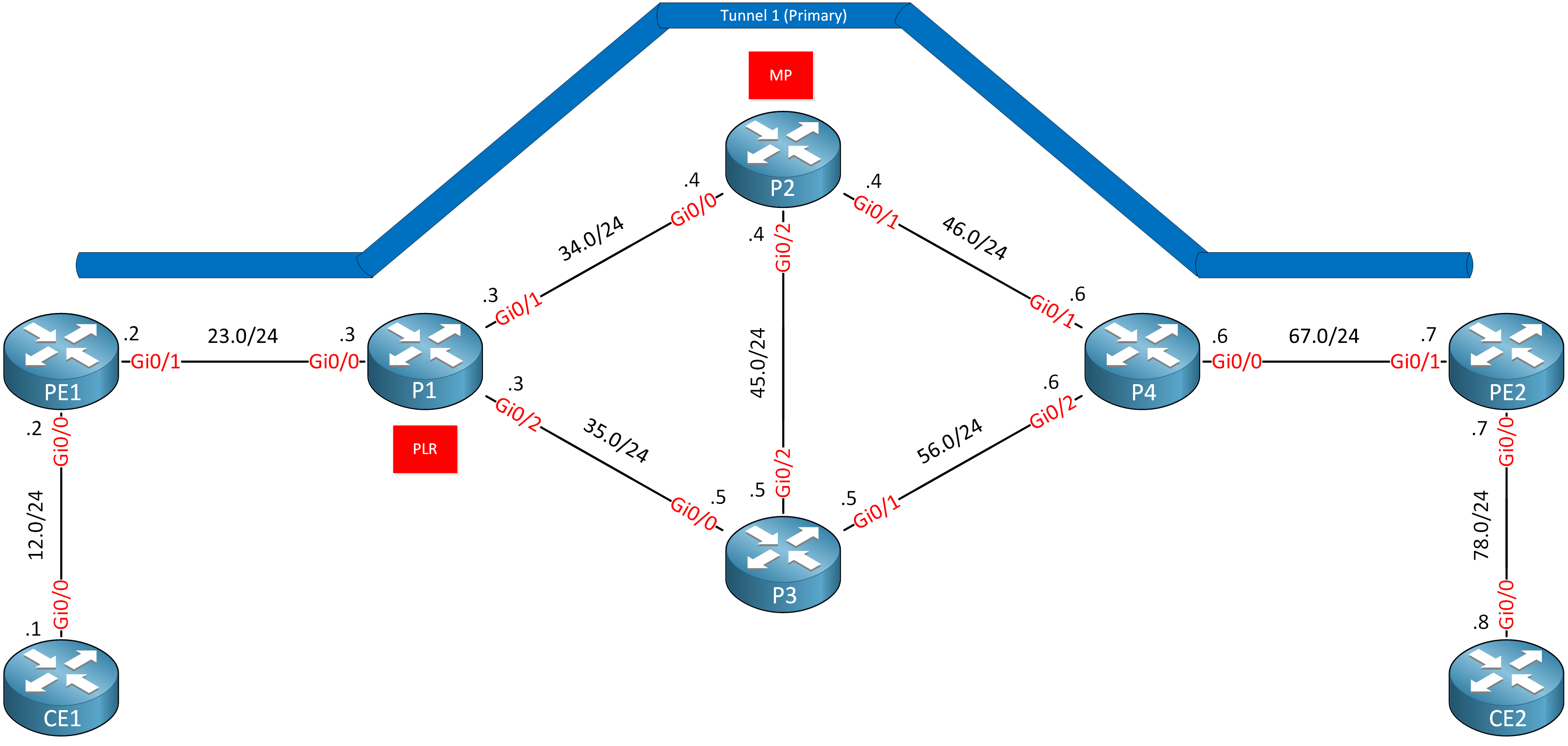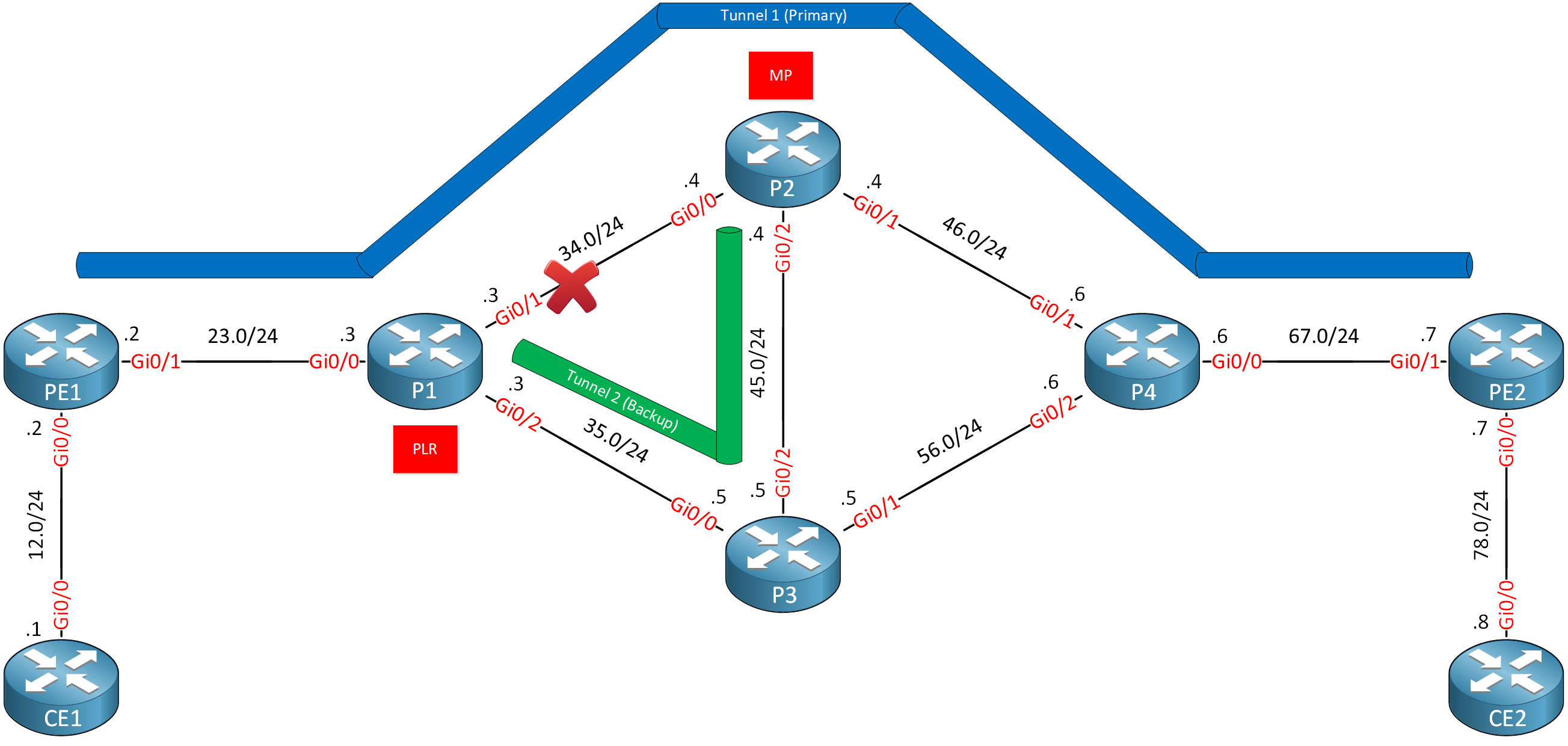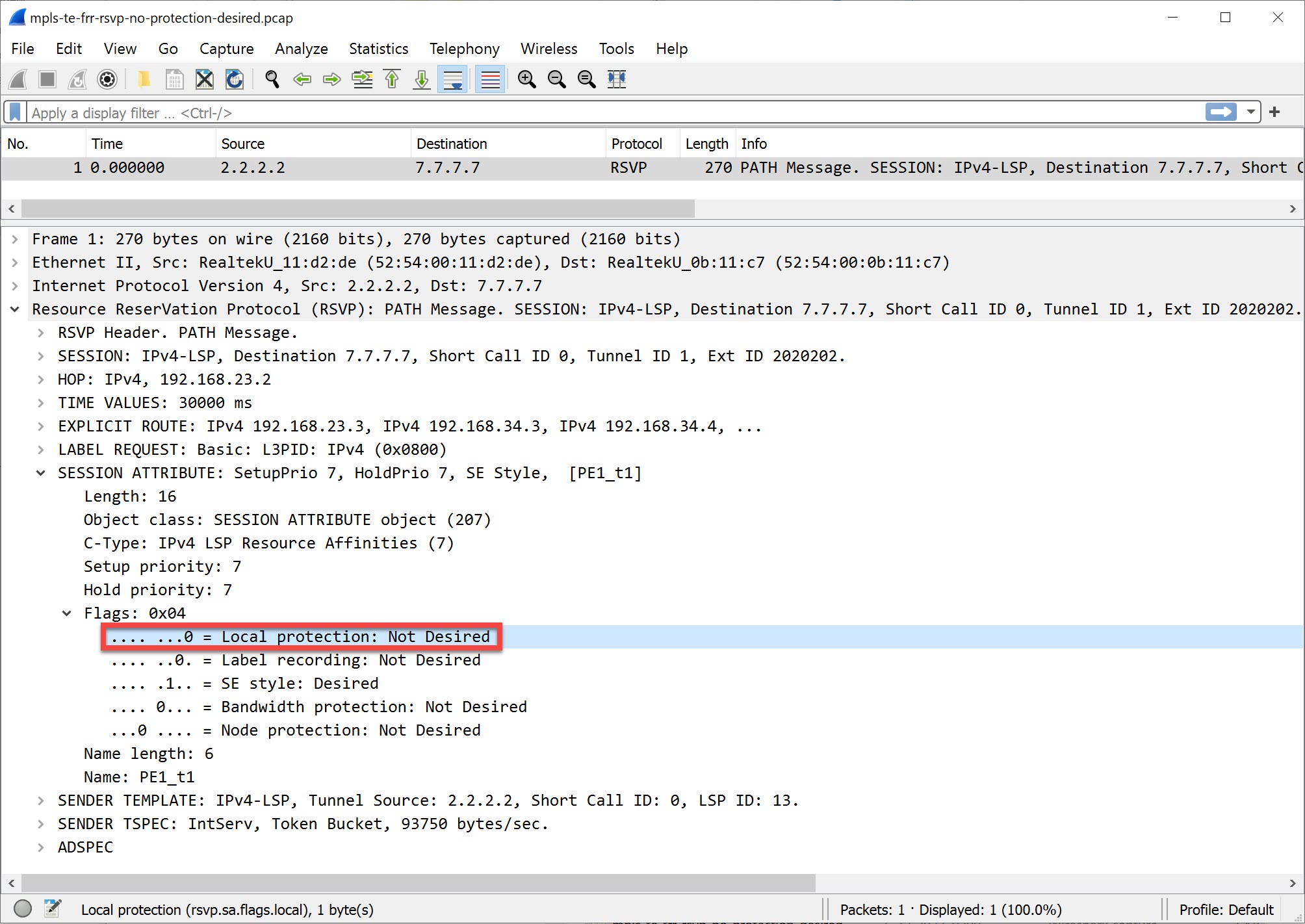Fast Reroute (FRR) protects MPLS TE LSPs from link and node failures. We achieve this by locally repairing the LSP of a primary tunnel using backup tunnels. This allows traffic to continue while the headend router attempts to calculate a new best LSP. When the primary tunnel fails, the backup tunnel is used immediately. This takes less than ~50 ms. There are two protection types:
- Link protection
- Node protection
In this lesson, we’ll take a look at link protection.
Configuration
This is the topology we’ll use:

All the PE and P routers are running MPLS TE. We have a TE tunnel from PE1 to PE2. Check out the MPLS TE configuration lesson if you are unsure how to configure MPLS TE. Our goal is to protect the link between P1 and P2:

We achieve this by creating a backup tunnel between P1 and P2 that goes through P3. P1 is the router where we configure the backup tunnel. This makes P1 the Point of Local Repair (PLR). P2 is where we terminate the backup tunnel and where our traffic rejoins the LSP of the primary tunnel. This makes P2 the Merge Point (MP). Backup tunnels bypassing a single link are called next-hop (NHOP) backup tunnels. It’s called a NHOP backup tunnel because it terminates at the next hop (P2 is the next hop from P1’s perspective).
- Configurations
- CE1
- CE2
- P1
- P2
- P3
- P4
- PE1
- PE2
Want to take a look for yourself? Here you will find the startup configuration of each device.
I use IOSv Software (VIOS-ADVENTERPRISEK9-M), Version 15.9(3)M4 on all routers.
Before we start with the fast reroute configuration, I want to emphasize that I use an explicit path on PE1 for the primary tunnel:
PE1#show ip explicit-paths
PATH EXCLUDE_P3 (strict source route, path complete, generation 6)
1: exclude-address 5.5.5.5This explicit path forces the traffic through P2. When P2 is unavailable, the tunnel will go down. This is important for this lab because, otherwise, once fast reroute is enabled, you’ll see that PE1 will use the backup tunnel only for a few seconds before switching over to a new path because of recalculation.
Without Fast Reroute
Before we enable fast reroute, there’s something I’d like to show you in Wireshark. I’ll enable a packet capture on the link between PE1 and P1, and we’ll shut/no shut the tunnel interface on PE1:
PE1(config)#interface Tunnel 1
PE1(config-if)#shutdown
PE1(config-if)#no shutdownIn the RSVP PATH message, you’ll see this:

MPLS TE FRR RSVP no protection desired
Above, you can see that PE1 doesn’t require link protection (local protection) at this moment.
With Fast Reroute
It’s time to configure fast reroute link protection.
PE1
We’ll start with PE1. We need to add one command to the tunnel interface:
PE1(config)#interface Tunnel 1
PE1(config-if)#tunnel mpls traffic-eng fast-rerouteLet’s take another look at the RSVP PATH message:

MPLS TE FRR RSVP link protection desired
Above, you now see that PE1 requests link protection for this tunnel. You can also verify this with the following show command:
PE1#show ip rsvp sender detail | include Flags
Flags: (0x7) Local Prot desired, Label Recording, SE StyleThis completes the configuration of PE1.
P1
Let’s configure P1. Our backup tunnel should only bypass the link between P1 and P2. This means the backup tunnel should go from P1 to P3 and terminate at P2. Without an explicit path, P1 would take the direct path to P2. To accomplish this, I’ll configure an explicit path that includes the addresses of P3 and P2:
P1(config)#ip explicit-path name INCLUDE_P3_P2 enable
P1(cfg-ip-expl-path)# next-address 192.168.35.5
P1(cfg-ip-expl-path)# next-address loose 4.4.4.4- Unit 1: Introduction
- Unit 2: LDP (Label Distribution Protocol)
- Unit 3: MPLS VPN
- VRFs (Virtual Routing and Forwarding)
- MPLS L3 VPN Explained
- MPLS L3 VPN Configuration
- MPLS L3 VPN BGP Allow AS in
- MPLS L3 VPN BGP AS Override
- MPLS L3 VPN PE-CE RIP
- MPLS L3 VPN PE-CE EIGRP
- MPLS L3 VPN PE-CE OSPF
- MPLS L3 VPN PE-CE OSPF Default Route
- MPLS L3 VPN PE-CE OSPF Global Default Route
- MPLS L3 VPN PE-CE OSPF Sham Link
- VRF Lite Route Leaking
- MPLS VPN Extranet Route Leaking
- MPLS VPN VRF Export Map
- MPLS VPN VRF Import Map
- MPLS over FlexVPN
- Unit 4: MPLS L2 Encapsulation
- Unit 5: IPv6 MPLS
- Unit 6: MPLS Traffic Engineering (TE)
- Introduction to MPLS Traffic Engineering (TE)
- MPLS Traffic Engineering (TE) IS-IS Configuration
- MPLS Traffic Engineering (TE) OSPF Configuration
- MPLS TE RSVP-TE
- MPLS TE Static Routes
- MPLS TE Policy Based Routing (PBR)
- MPLS TE Autoroute Announce
- MPLS TE Autoroute Destination
- MPLS TE Autoroute Metric
- MPLS TE Unequal Cost Load Balancing
- MPLS TE Load Balancing between IGP and TE
- MPLS TE Forwarding Adjacency
- MPLS TE Path Options Explicit
- MPLS TE Class-Based Tunnel Selection (CBTS)
- MPLS TE Metric
- MPLS TE Setup and Hold Priority
- MPLS TE Attribute Flag and Affinity
- MPLS TE Reoptimization
- MPLS TE Fast Reroute (FRR)
- MPLS TE Fast Reroute Path Link Protection
- MPLS TE Fast Reroute Path Node Protection
- MPLS TE FRR RSVP Hello Support
- MPLS TE DiffServ Aware (DS-TE) Traditional
- MPLS TE Diffserv-Aware (DS-TE) IETF Mode
- MPLS VPN over MPLS TE Tunnels
- MPLS TE Per VRF TE tunnel